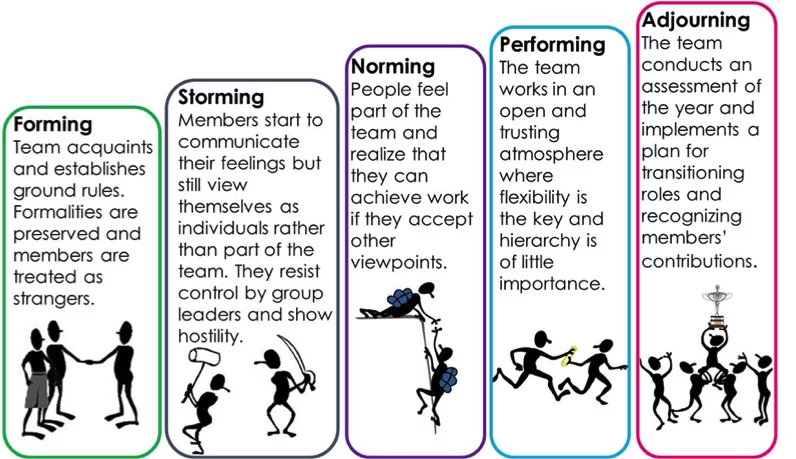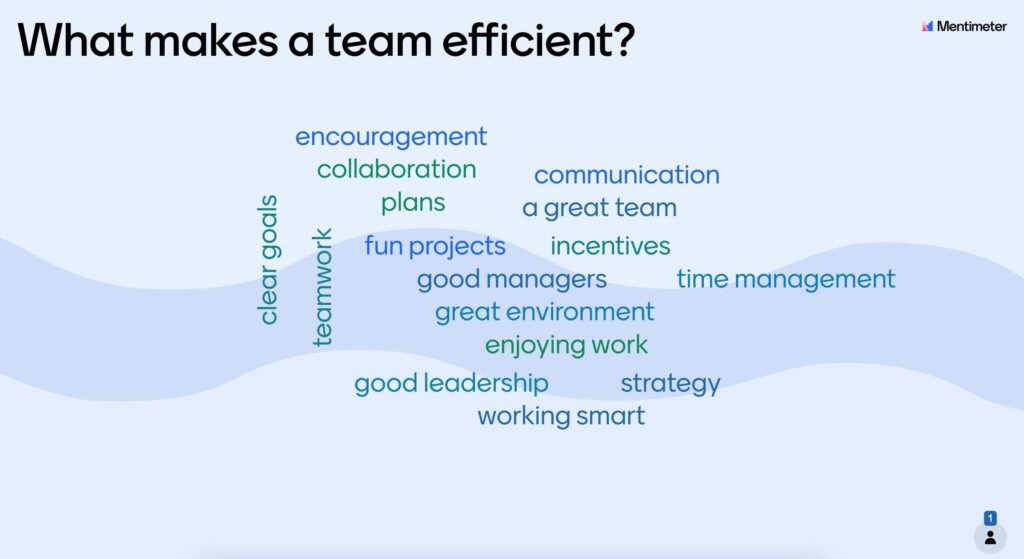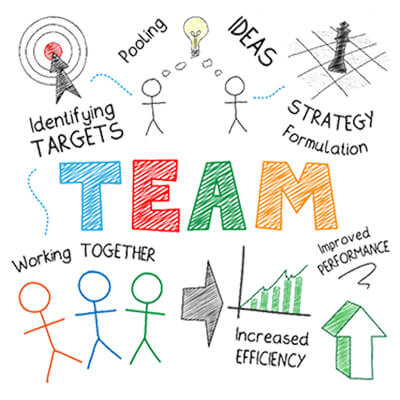Table of Contents
ToggleTEAMWORK/TEAM PLANNING/TEAM PROCESS
A team is a small number of people with complementary skills who are committed to a common purpose, set of performance goals, and approach for which they hold themselves mutually accountable (Eleanor.J.Sullivan,2005,2013) Effective leadership and management in nursing).
- Small number: 5-10 people
- Complementary Skills-Appropriate balance or mix of skills and traits.
- Commitment to a common purpose and performance Goals-Specific performance goals are an integral part of the purpose.
- Commitment to a common Approach-Team member must agree on who will do a particular job and develop a common approach.
- Mutual Accountability-Team accountability is about the sincere promise we make to others and ourselves; these are the basis of commitment and trust.
A team refers to two or more people acting interdependently in a unified manner towards the achievement of a common goal.
A health team is a group of people who share a common health goal.
Members of a health team include technical staff i.e. doctors, Clinical Officers, laboratory tech, nurses midwives, radiologists, and support staff i.e. cooks, cleaners, drivers, watch men etc.
Team planning is the process of developing strategic and operational plans for your team and aligning the team’s work with the business’s goals.
Teamwork: The process of people actively working together to accomplish common goals.
What are the differences between a Group and a Team?
Group | Team | |
Focus | Strong, clearly focused | Shared leadership roles |
Leadership Roles | Shared | Individual and mutual |
Accountability | Individual | Individual and mutual |
Purpose | Same as broader organizational mission | Specific team purpose that the team delivers |
Work Products | Individual work products | Collective work products |
Meetings | Runs efficient meetings | Encourages open-ended discussions, active problem solving |
Performance Measurement | Indirectly by its influence on others | Directly by collective work products |
Decision Making | Discusses, decides, and delegates | Discusses, decides, and does real work together |

TUCKMAN’S STAGES OF GROUP DEVELOPMENT(Stages of Team building )
These stages are commonly known as: Forming, Storming, Norming, Performing, and Adjourning. Tuckman’s model explains that as the team develops maturity and ability, relationships establish, and leadership style changes to more collaborative or shared leadership.
1. Forming
- The initial forming stage is the process of putting the structure of the team together. It is a period of transition from individual to group member status. They may be uncertain about their roles and responsibilities within the team. The focus is on building relationships and establishing trust. Team leaders help in facilitating introductions and creating a positive team environment .
2. Storming
- In the storming stage, conflicts and disagreements may arise as team members start to express their ideas and opinions. This stage is characterized by competition and power struggles. Team leaders need to manage conflicts and ensure effective communication to prevent the team from getting stuck in this stage.
3. Norming
- In the norming stage, team members start to resolve their conflicts and establish norms and rules for working together. They develop a sense of cohesion and collaboration. Roles and responsibilities become clearer, and trust among team members increases. Team leaders should encourage open communication and provide support to maintain the positive momentum.
4. Performing
- The performing stage is when the team reaches its peak performance. Team members work together smoothly and efficiently towards achieving their goals. They have a high level of trust, collaboration, and accountability. Team leaders can step back and provide guidance when needed, as the team is capable of self-management.
5. Adjourning
- In the adjourning stage, the team completes its project or task and disbands. This stage is often overlooked, but it is important for reflecting on the team’s achievements and learning from the experience. Team members have an opportunity to celebrate their successes and identify areas for improvement in future projects
Team leader’s role
- Involvement in the selection process: Team leaders may participate in the recruitment and interview process to assess potential candidates for the team. They may provide input on the desired skills, experience, and qualities needed for the team members.
- Ensuring achievement of standards and discipline: Team leaders help in maintaining standards and discipline within the team. They ensure that team members adhere to established guidelines, policies, and procedures.
- Allocation and scheduling of duties: Team leaders are responsible for assigning tasks and responsibilities to team members based on their skills and expertise. They ensure that work is distributed effectively and that each team member has a clear understanding of their role.
- Controlling the use of resources: Team leaders oversee the allocation and utilization of resources within the team. They ensure that resources are used efficiently and effectively to support the team’s objectives.
- Directing the formation of team strategy and plans: Team leaders help in developing the team’s strategy and plans. They provide guidance and direction to the team, ensuring that their efforts align with the overall goals and objectives of the organization.
- Acting as a spokesman/negotiator for the team: Team leaders represent the team in interactions with other stakeholders, such as higher levels of management or external partners. They serve as the primary point of contact and advocate for the team’s needs and interests.
- Providing an open communication system: Team leaders establish and maintain an open and effective communication system within the team. They encourage open dialogue, collaboration, and information sharing among team members.
- Making follow-ups and encouraging members to do so: Team leaders follow up on the progress of tasks and projects, ensuring that deadlines are met and objectives are achieved. They also encourage team members to do the same, promoting accountability and a proactive approach to work.
- Clarifying objectives and organizational policies to members: Team leaders ensure that team members have a clear understanding of the objectives and goals of the team. They also communicate organizational policies and guidelines to ensure compliance and alignment.
- Setting Clear Goals: Team leaders are responsible for defining and communicating clear goals and objectives to their team members.
- Providing Direction: Team leaders provide guidance and direction to their team members, ensuring that everyone understands their roles and responsibilities.
- Delegating Tasks: Team leaders delegate tasks and responsibilities to team members based on their skills and strengths, ensuring an efficient distribution of workload.
- Monitoring Progress: Team leaders monitor the progress of projects and tasks, ensuring that they are on track and taking necessary actions to address any issues or delays.
- Facilitating Communication: Team leaders foster open and effective communication within the team, encouraging collaboration, sharing of ideas, and resolving conflicts.
- Coaching and Mentoring: Team leaders provide guidance, support, and mentorship to team members, helping them develop their skills and reach their full potential.
- Performance Management: Team leaders assess and evaluate the performance of team members, providing feedback, recognition, and addressing any performance issues.
- Resource Management: Team leaders manage and allocate resources effectively, ensuring that the team has the necessary tools, equipment, and support to accomplish their tasks.
- Problem Solving: Team leaders identify and address problems and obstacles that may arise during projects, finding solutions and making decisions to keep the team on track.
- Decision Making: Team leaders make informed decisions based on their expertise and input from team members, considering the impact on the team and the organization.
- Motivating and Inspiring: Team leaders motivate and inspire their team members, fostering a positive and productive work environment that encourages creativity and innovation.
- Building Relationships: Team leaders build strong relationships with team members, stakeholders, and other departments, promoting collaboration and effective teamwork.
- Continuous Improvement: Team leaders encourage a culture of continuous improvement, seeking opportunities to enhance processes, productivity, and team performance.
- Representing the Team: Team leaders represent the team’s interests and advocate for their needs within the organization, ensuring that they have the necessary support and resources.
Benefits of Teamwork
- Enhanced Problem Solving: Teamwork allows for the exchange of diverse perspectives, leading to more effective problem-solving. Each team member can contribute their ideas, resulting in better decisions, products, or services.
- Increased Efficiency: By dividing tasks among team members based on their abilities and knowledge, teamwork enables tasks to be completed faster. The collaborative effort of a team can accomplish more in less time compared to an individual working alone.
- Healthy Competition: Healthy competition within a team can motivate individuals and drive the team to excel. It encourages team members to push their limits, leading to growth and improvement.
- Relationship Development: Working together as a team creates stronger relationships among team members. Over time, team members become well-acquainted with each other, leading to increased bonding and a better understanding of each other’s strengths and weaknesses.
- Utilization of Unique Qualities: Each team member possesses unique knowledge, skills, and abilities that can benefit the entire team. Through teamwork, these qualities can be shared, allowing team members to learn from each other and enhance their productivity.
- Improved Morale: Teamwork empowers employees by giving them greater responsibility and control over decision-making processes. This increased authority and ownership can lead to improved morale, a more rewarding work environment, and lower turnover rates. Additionally, working on a team provides a sense of belonging and recognition, fostering pride in one’s work and company.
- Innovation and Creativity: Working together within a team encourages innovation and creativity. By bringing together individuals with different backgrounds and ideas, teamwork creates an environment where new ideas can flourish.
- Learning and Personal Growth: Being part of a team allows individuals to learn from their colleagues and expand their knowledge and skills. Through knowledge sharing, team members can develop new concepts, learn from each other’s experiences, and grow both personally and professionally.
- Increased Job Satisfaction: Teamwork contributes to higher job satisfaction. When team members feel valued, supported, and engaged in their work, they are more likely to be satisfied with their job. This positive work environment can lead to greater overall happiness and well-being.
- Resilience and Adaptability: Teams are better equipped to handle challenges and adapt to changes. By leveraging the collective knowledge and skills of team members, teams can navigate obstacles more effectively and find innovative solutions.
Symptoms of inadequate/lack of teamwork in the workplace.
- Work overload: When team members are overwhelmed with excessive workloads, it can lead to stress, burnout, and decreased collaboration.
- Decision making difficulties and delays: If there is a lack of teamwork, decision making can become slow and ineffective, resulting in delays and missed opportunities.
- Poor scheduling: When there is a lack of coordination and communication within a team, scheduling conflicts and inefficiencies can arise, leading to missed deadlines and decreased productivity.
- Uneven work distribution: Inadequate teamwork can result in an uneven distribution of work, with some team members shouldering a disproportionate amount of tasks, while others may feel underutilized.
- Poor information flow: When there is a lack of effective communication and collaboration, important information may not be shared or may be misunderstood, leading to errors, misunderstandings, and inefficiencies.
- General hostility: In a team lacking teamwork, there may be a negative and hostile atmosphere, with team members not supporting or respecting each other, which can hinder collaboration and productivity.
- Problems that will not go away: If issues and conflicts within the team persist without resolution, it indicates a lack of teamwork and the inability to work together to find solutions.
- Apathy: When team members lack motivation, engagement, and enthusiasm for their work, it can be a sign of inadequate teamwork and a lack of shared goals and purpose.
- High-level grievances: If there are frequent and unresolved conflicts or grievances among team members, it indicates a breakdown in teamwork and a lack of effective communication and conflict resolution.
- Workers over dependent on managers: In a team lacking teamwork, team members may rely heavily on managers for guidance and decision making, rather than collaborating and taking initiative themselves.
- No initiative: When team members lack initiative and fail to take ownership of their work and contribute ideas, it can indicate a lack of teamwork and a disengaged team.
- Decisions are poorly executed: Inadequate teamwork can result in poor execution of decisions, as there may be a lack of coordination, communication, and accountability within the team

Maintaining Team Spirit or Factors should be considered for effective team work.
Recognition:
- Acknowledging and praising team members for their successes is important.
- Verbal recognition and appreciation can go a long way in boosting team spirit.
Nature of work:
- Helping team members understand the value and importance of their work, even if it may seem dull, can increase motivation.
- Explaining how each task contributes to the overall objectives of the organization can make the work more meaningful.
Responsibility:
- Encouraging team members to take decisions and giving them a sense of responsibility can increase motivation.
- Empowering employees to make decisions shows trust and confidence in their abilities.
Remuneration:
- Timely and fair payment of salaries, wages, and allowances can motivate team members.
- Ensuring that team members are compensated appropriately for their work is important for maintaining their motivation.
Adequate staffing:
- Having enough staff to handle the workload is crucial for maintaining team spirit.
- Overburdening team members with excessive work can lead to burnout and decreased morale.
Resources and equipment:
- Providing team members with the necessary resources and equipment to perform their tasks effectively can boost motivation.
- Having access to the right tools and resources makes the work easier and more efficient.
Incentives:
- Offering incentives such as uniforms, free medical care, housing, or transportation can motivate team members.
- These incentives provide additional benefits and rewards that can enhance team spirit.
Other include;
- Encourage autonomy and empowerment: Give team members the freedom to make decisions and take ownership of their work. This can boost their motivation and sense of responsibility.
- Provide opportunities for professional development: Offer training programs, workshops, and mentorship opportunities to help team members enhance their skills and knowledge. This shows that you value their growth and can increase their engagement and commitment to the team.
- Foster a culture of collaboration: Create an environment where teamwork is encouraged and celebrated. Encourage team members to collaborate on projects, share ideas, and support each other. This can strengthen relationships and enhance team spirit.
- Celebrate achievements and milestones: Recognize and celebrate both individual and team accomplishments. This can be done through public recognition, rewards, or team celebrations. Acknowledging achievements boosts morale and reinforces a positive team spirit.
- Encourage open and honest communication: Foster an atmosphere where team members feel comfortable expressing their thoughts, concerns, and ideas. Encourage active listening and provide opportunities for feedback and discussion. This promotes trust, transparency, and a sense of belonging within the team.
- Promote work-life balance: Support a healthy work-life balance by offering flexible work arrangements, promoting self-care, and encouraging time off. When team members feel supported in their personal lives, they are more likely to be engaged and motivated at work.
- Lead by example: As a leader, demonstrate the behaviors and attitudes you want to see in your team. Show enthusiasm, positivity, and a strong work ethic. Lead with integrity, communicate effectively, and be responsive to the needs of your team members. Your actions can inspire and motivate others to maintain team spirit.
Characteristics of an Ineffective Team
- Lack of Clarity on Mission: An ineffective team often struggles to clearly describe its mission or purpose. This lack of clarity can lead to confusion and a lack of direction within the team.
- Formal and Tense Meetings: Ineffective teams often have formal, stuffy, or tense meetings. This can create an uncomfortable atmosphere and hinder open communication and collaboration.
- Lack of Accomplishment: Despite a great deal of participation, ineffective teams tend to have little accomplishment. This could be due to a lack of clear goals, poor coordination, or ineffective decision-making processes.
- Poor Communication: Ineffective teams may have a lot of talking, but not much effective communication. This can result in misunderstandings, misalignment, and a lack of shared understanding among team members.
- Private Disagreements: Instead of addressing disagreements openly, ineffective teams tend to air their grievances in private conversations. This lack of open communication can lead to unresolved conflicts and a breakdown in trust within the team.
- Lack of Meaningful Involvement: Ineffective teams often have decisions made solely by the formal leader, with little meaningful involvement from other team members. This can lead to a lack of ownership and engagement among team members.
- Low Trust: Members of ineffective teams may not be open with each other due to low levels of trust. This lack of trust can hinder collaboration, information sharing, and effective teamwork,
- Confusion or Disagreement about Roles: Ineffective teams may experience confusion or disagreement about roles and responsibilities. This can lead to duplication of efforts, gaps in accountability, and a lack of clarity on who is responsible for what.
- Lack of Cooperation from Others: Ineffective teams may struggle to get cooperation from people in other parts of the organization who are critical to their success. This can hinder the team’s ability to access necessary resources and support.
- Lack of Assessment: Ineffective teams often exist for a significant period of time without assessing their functioning. This lack of self-reflection and evaluation can prevent the team from identifying and addressing their weaknesses.


The notes are wonderful